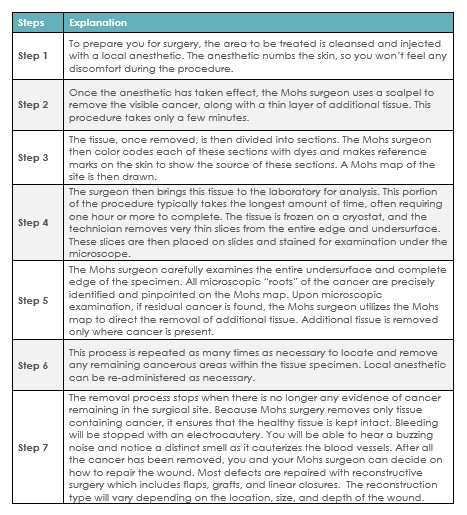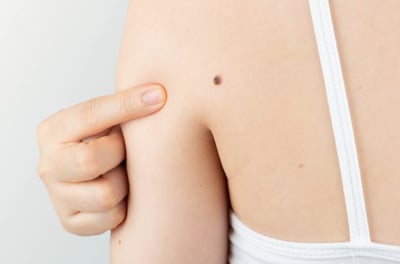
You or someone you know may have been diagnosed with skin cancer and were told the best treatment option is Mohs surgery, but what is Mohs surgery? If you want to learn more about Mohs surgery you have come to the right place.
What is Mohs Surgery?
Let’s start from the beginning … Skin cancer may initially appear as a bump or irregular patch on the surface of the skin. As cancer grows, the size or shape of the visible skin mass may change. Some skin cancers can be deceptively large, sending out “roots” and extensions that are far more extensive under the skin than they appear to be from the surface. If left untreated, skin cancer may spread into nearby muscle tissue, blood vessels, nerves, cartilage, and depending on the type of skin cancer, lymph nodes, and other organs.
Mohs Micrographic surgery is a specialized, highly effective technique used to track and remove these cancerous “roots.” The goal of Mohs surgery is to remove as much of the skin cancer as possible while doing minimal damage to surrounding healthy tissue.
Mohs surgery differs from other skin cancer treatments in that it involves immediate and complete microscopic examination of the removed cancerous tissue so that all “roots” and extensions of the cancer are identified and eliminated.
According to Dr. Ashlynne Clark, Board-Certified Dermatologist and Fellowship-Trained Mohs Surgeon with Forefront Dermatology, “it is important to note that Mohs surgery is not appropriate for the treatment of all skin cancers. Mohs surgery is best for cancers located in areas of the body where maximal preservation of healthy tissue is critical for cosmetic or functional purposes, such as areas around the eyes, ears, nose, mouth, hairline, hands, and feet.”

How effective is Mohs surgery?
Due to the methodical manner in which tissue is removed and examined, Mohs surgery is recognized as the skin cancer treatment with the highest cure rate. It has a cure rate of up to 99%, as compared to a cure rate of 85% to 92% for standard skin cancer surgery. According to Dr.
Clark, “As a Mohs surgeon, we take pride in achieving the best outcome possible for each individual patient. From the initial consultation to the final post-operative visit, as your surgeon, I always strive to make sure that your experience is a positive one.
Risks and Potential Complications
“Even though Mohs surgery is an improvement to standard skin cancer surgery, rare complications are possible, as with any surgical procedure,” explains Dr. Clark. “Potential complications may include bruising and swelling around the wound, bleeding, and infection.”
What happens during a Mohs surgical procedure?
Mohs surgery is done on an outpatient basis in a procedure room with a nearby laboratory that allows the surgeon to examine the tissue after it is removed. The procedure, on average, requires less than four hours. However, it is not possible to predict how long the procedure will be, as the extent of the skin cancer “roots” cannot be estimated in advance. This table walks you through each step of the Mohs surgery process. While Mohs surgery can be a scary treatment to walk into, your Mohs surgeon will ensure that at each step in the process you are comfortable and understand what is happening next. As a patient, never be afraid to ask a question of your Mohs surgeon – they are here to make sure your experience is a positive one.
Be Proactive
Remember, early detection saves lives and a simple, yearly in-office skin screening with your local board-certified Forefront Dermatologist can truly mean the difference between life and death. Find a dermatologist near you today.





